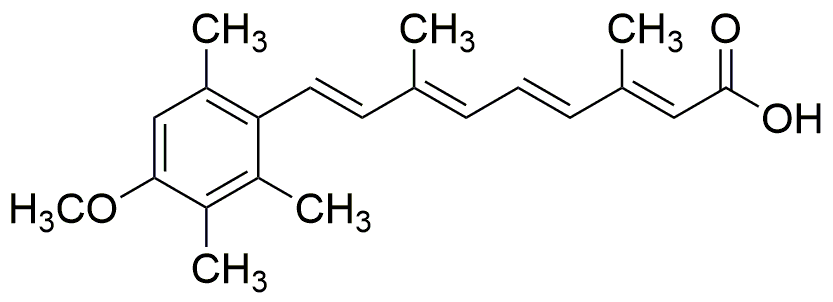Acitretin is widely utilized in research focused on:
- Dermatology Treatments: Acitretin is primarily used in the treatment of severe psoriasis and other skin disorders. Its effectiveness in reducing skin cell production makes it a vital option for patients who do not respond to conventional therapies.
- Research on Retinoid Mechanisms: In scientific studies, Acitretin serves as a model compound for understanding the action of retinoids in cellular processes, including differentiation and proliferation. This research is crucial for developing new dermatological therapies.
- Pharmaceutical Development: The compound is significant in the pharmaceutical industry for developing new formulations and delivery systems, enhancing the bioavailability and efficacy of retinoid-based treatments.
- Cosmetic Applications: Acitretin is also explored in cosmetic formulations aimed at anti-aging and skin rejuvenation, leveraging its ability to promote skin cell turnover and improve texture.
- Oncology Research: Emerging studies suggest potential applications in oncology, where Acitretin may play a role in inhibiting tumor growth and enhancing the effectiveness of certain cancer therapies.
General Information
Properties
Safety and Regulations
Applications
Acitretin is widely utilized in research focused on:
- Dermatology Treatments: Acitretin is primarily used in the treatment of severe psoriasis and other skin disorders. Its effectiveness in reducing skin cell production makes it a vital option for patients who do not respond to conventional therapies.
- Research on Retinoid Mechanisms: In scientific studies, Acitretin serves as a model compound for understanding the action of retinoids in cellular processes, including differentiation and proliferation. This research is crucial for developing new dermatological therapies.
- Pharmaceutical Development: The compound is significant in the pharmaceutical industry for developing new formulations and delivery systems, enhancing the bioavailability and efficacy of retinoid-based treatments.
- Cosmetic Applications: Acitretin is also explored in cosmetic formulations aimed at anti-aging and skin rejuvenation, leveraging its ability to promote skin cell turnover and improve texture.
- Oncology Research: Emerging studies suggest potential applications in oncology, where Acitretin may play a role in inhibiting tumor growth and enhancing the effectiveness of certain cancer therapies.
Documents
Safety Data Sheets (SDS)
The SDS provides comprehensive safety information on handling, storage, and disposal of the product.
Product Specification (PS)
The PS provides a comprehensive breakdown of the product’s properties, including chemical composition, physical state, purity, and storage requirements. It also details acceptable quality ranges and the product's intended applications.
Certificates of Analysis (COA)
Search for Certificates of Analysis (COA) by entering the products Lot Number. Lot and Batch Numbers can be found on a product’s label following the words ‘Lot’ or ‘Batch’.
*Catalog Number
*Lot Number
Certificates Of Origin (COO)
This COO confirms the country where the product was manufactured, and also details the materials and components used in it and whether it is derived from natural, synthetic, or other specific sources. This certificate may be required for customs, trade, and regulatory compliance.
*Catalog Number
*Lot Number
Safety Data Sheets (SDS)
The SDS provides comprehensive safety information on handling, storage, and disposal of the product.
DownloadProduct Specification (PS)
The PS provides a comprehensive breakdown of the product’s properties, including chemical composition, physical state, purity, and storage requirements. It also details acceptable quality ranges and the product's intended applications.
DownloadCertificates of Analysis (COA)
Search for Certificates of Analysis (COA) by entering the products Lot Number. Lot and Batch Numbers can be found on a product’s label following the words ‘Lot’ or ‘Batch’.
*Catalog Number
*Lot Number
Certificates Of Origin (COO)
This COO confirms the country where the product was manufactured, and also details the materials and components used in it and whether it is derived from natural, synthetic, or other specific sources. This certificate may be required for customs, trade, and regulatory compliance.

